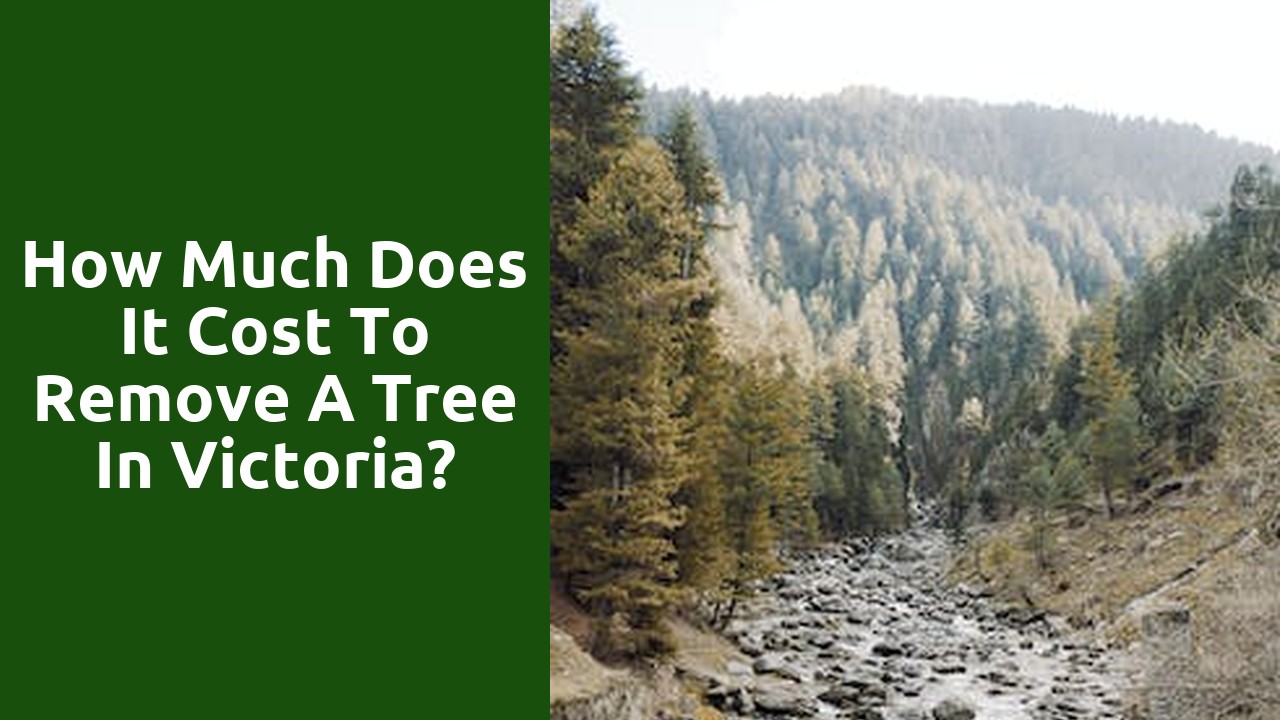How much does it cost to remove a tree in Victoria?

Tree Size and Height
Tree Size and Height
One of the defining characteristics of trees is their size and height. Trees come in a wide range of sizes, from small saplings to towering giants that dominate the landscape. The size of a tree is primarily determined by its age and species. Some trees, like the Bonsai, are intentionally kept small through careful pruning and cultivation techniques. Others, such as the Coastal Redwood, can grow to astonishing heights, reaching over 300 feet.
When it comes to height, certain tree species are more prone to growing taller than others. For instance, the Douglas Fir is known for its impressive height, often towering over other trees in the forest. The mighty Oak tree also stands tall, not only in physical stature but also in cultural significance. People have long associated height with strength and grandeur, and trees are no exception. The sight of a towering tree can inspire awe and wonder, reminding us of the majesty of nature.
Distance and Accessibility
In today's fast-paced world, distance and accessibility play a crucial role in the way we live our lives. The advancements in technology and transportation have brought us closer, making the world seem smaller and more interconnected. With the click of a button, we can connect with people on the other side of the globe, making it easier to conduct business, share knowledge, and build relationships.
However, distance still plays a significant role in our daily lives. The physical distance between places can have a direct impact on our ability to access certain resources or opportunities. Remote areas may face challenges when it comes to accessing education, healthcare, or even basic amenities. The cost and time involved in traveling long distances can also pose obstacles for some individuals, limiting their ability to explore new opportunities or connect with people outside their immediate surroundings. As society continues to strive for inclusivity and equality, finding ways to bridge these gaps in accessibility becomes paramount.
Tree Condition and Health
One important aspect of maintaining a healthy environment is the condition and health of our trees. Trees provide numerous benefits to our surroundings, such as improving air quality, reducing noise pollution, and offering shade. However, just like any living organism, trees can face various issues that may impact their overall condition and health.
One common issue that affects trees is pest infestation. Insects, such as aphids or beetles, can damage the leaves, branches, or even the trunk of a tree. These pests not only weaken the tree but also make it more susceptible to diseases. Another factor that can impact tree health is environmental stress. Changes in temperature, excessive drought, or polluted soil can hinder a tree's ability to thrive. In some cases, this can lead to increased vulnerability to pests and diseases, which further deteriorate the tree's condition. Ensuring the optimal condition and health of trees is crucial for the well-being of both the natural environment and the people who benefit from their presence.
Type of Tree
Oak Tree:
The Oak Tree, known for its sturdy and majestic presence, is a popular choice among homeowners and landscapers alike. With its sturdy trunk and sprawling branches, the Oak Tree provides ample shade and adds visual appeal to any outdoor space. One of its distinctive features is its deep, penetrating root system, which allows the tree to withstand harsh weather conditions and prevents soil erosion. Additionally, Oak Trees are highly valued for their longevity, often living for hundreds of years. Their ability to adapt to various soil types and climates makes them a versatile choice for gardens and parks.
Permit and Approval Requirements
When starting a new construction project, it is important to understand the various permit and approval requirements that must be met. These requirements are established by local and state governments to ensure that buildings and renovations comply with safety and zoning laws. Failure to obtain the necessary permits and approvals can result in hefty fines, delays, or even having to tear down non-compliant structures.
The specific permits and approvals needed will vary depending on the location and scope of the project. Common examples include building permits, electrical permits, plumbing permits, and mechanical permits. These permits ensure that the construction follows the applicable codes and regulations, such as fire safety, structural integrity, and energy efficiency. Additionally, specific approvals might be required for projects located in historic districts, flood zones, or environmentally sensitive areas to preserve historical character or safeguard against natural disasters. It is crucial to thoroughly research and understand the permit and approval requirements for your specific project to avoid any legal or logistical complications down the line.
Equipment and Labor
Equipment and Labor:
When it comes to completing any task efficiently and effectively, having the right equipment is paramount. A well-equipped workforce can tackle projects of various scales with ease, minimizing errors and ensuring smooth operations. From heavy machinery to specialized tools, investing in the right equipment can significantly increase productivity and reduce the overall time required to complete a project. Additionally, reliable and properly maintained equipment can enhance worker safety and minimize the risk of accidents on the job site.
While having the right equipment is crucial, the role of skilled labor cannot be overstated. A skilled and knowledgeable workforce is the backbone of any successful endeavor. Whether it is a construction project, manufacturing process, or any other industry, having trained workers who understand the intricacies of their trade is essential. Skilled labor brings expertise and experience to the table, ensuring that tasks are executed with precision and professionalism. Moreover, well-trained workers are more likely to adapt to new technologies and techniques, thus keeping up with industry advancements and maintaining a competitive edge.
Related Links
Do I need permission to cut down a tree on my property Victoria?What is the average cost of tree removal in my area?